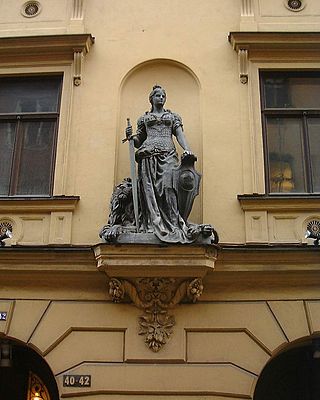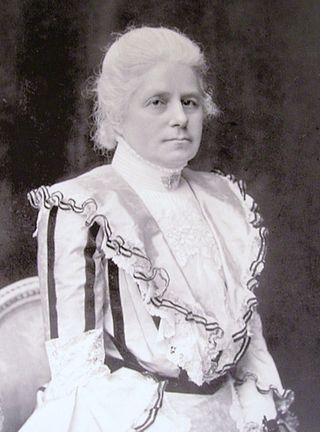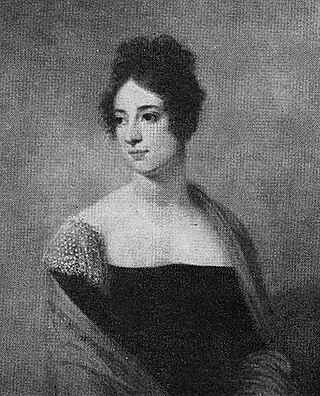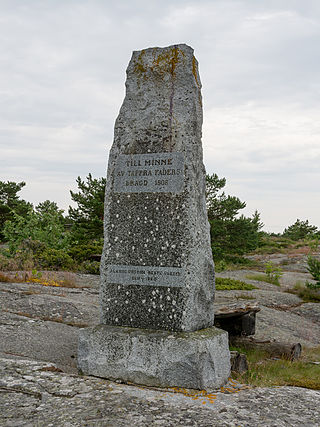Related Research Articles

Sture was a name borne by three distinct but interrelated noble families in Sweden in the Late Middle Ages and Early Modern Period. It was originally a nickname, meaning 'haughty, proud', but later became a surname. Particularly famous are the three regents from these families who ruled Sweden in succession during the fifty-year period between 1470 and 1520, namely:

Mother Svea or Mother Swea is the female personification of Sweden and a patriotic emblem of the Swedish nation.

Engelbrekt Engelbrektsson was a Swedish nobleman, rebel leader and military leader of German ancestry. He was the leader of the Engelbrekt rebellion in 1434 against Eric of Pomerania, king of the Kalmar Union. Engelbrekt Parish and Engelbrekt Church (Engelbrektskyrkan) in the Church of Sweden Diocese of Stockholm were both named in his honor.
Gösta Sandahl was a Swedish figure skater. He was the 1912 European Champion and the 1914 World Champion. He stopped participating in the sport in 1916 due to religious reasons, but made a temporary comeback in 1923, and won the Swedish Championships that year.

Louis Gallodier was a French ballet dancer and choreographer who spent the majority of his career in Sweden, where he was to have a great importance for the development of the ballet in Sweden as the ballet master of the Royal Swedish Ballet.
Eva Margareta Frölich, was a Swedish mystic, prophet, visionary and Pietistic writer.
Ottilia Sofia Littmarck was a Swedish actress and theatre director. She was a noted actress in Sweden in the late 19th century.

Ellen Fries was a Swedish feminist and writer. She became the first female Ph.D. in Sweden in 1883. She also founded several women's organizations.

Carl August Adlersparre was a Swedish count (1835), chamberlain (1838), poet, novelist and historian from the Adlersparre family. He was known under his pen name Albano.

Countess Anna Fridrica Wilhelmina von Hallwyl, née Kempe was a Swedish collector and donor whose accumulation of art and other objects constitute the current Hallwyl Museum in Stockholm.
Rikissa Magnusdotter of Sweden was a Swedish princess. She was the daughter of King Magnus III of Sweden and his Queen consort Hedwig of Holstein. At the age of six, she was entrusted to the nuns at St. Clara Priory in Stockholm. The nunnery had been given large donations and lands upon its foundation by King Magnus. Rikissa was the abbess of St. Clara Priory from at least 1335 until her death in 1348.
The Royal Swedish Naval Staff College was a Swedish Navy training establishment between 1898 and 1961, providing courses for naval officers. It was the home of the Swedish Navy's staff college, which provided advanced training for officers. It was located within the Stockholm garrison in Stockholm, Sweden.

Artillery and Engineering College was a Swedish Army training establishment active between 1878 and 1992, providing courses for artillery officers. It was located within the Stockholm Garrison in Stockholm, Sweden.

Tapetskolan vid Karlberg or Tapetväfveriet vid Karlbergs slott, also called Karlbergsfabriken, was a Swedish orphanage and a school for girls. It was founded by Ulrika Eleonora of Denmark, Queen Consort of King Charles XI of Sweden. She founded a large number of charitable institutions which were paid by her personally. The handicrafts school was situated at the royal summer residence Karlberg Palace which King Charles XI had purchased in 1688.

Charlotta Letitia Skjöldebrand née Ennes, was a Swedish court official. She served as Senior lady-in-waiting (överhovmästarinna) to Josefina, Queen of Sweden from 1835 to 1866.
Underlöjtnant was the lowest officer rank in the Swedish Army from 1835 to 1937 instead of the previous ranks of fänrik and cornet. Fänrik was reintroduced in 1914 with the same position as underlöjtnant, from 1926 with lower position.

The Battle of Kulminge was the culmination of the Åland riots during the Finnish War, fought between Sweden and Russia. The riot started in the Sockenstuga at 19 March 1808 and spread all over Åland, to finally culminate at Kumlinge at 9 or 10 May. 450 armed peasants, led by Henrik Gummerus, defeated and captured the equally strong Russian force under Colonel Vuitsch at their headquarters, just outside the Kulminge rectory. The peasants sustained three killed and three captured, while the Russians had one killed and eight wounded. After Vuitsch's capitulation, only about 50 Russian soldiers remained on Brändö who likewise, after a brief engagement, were made prisoners; all of Åland had thus been saved from Russian occupation.

Älvsborg, now generally known as Old Älvsborg or Älvsborg Castle to distinguish it from the later New Älvsborg and Älvsborg Fortress, was a medieval castle situated on the rocky outcrop known as Klippan, on the south bank of the Göta Älv river within the urban area of the modern city of Gothenburg. It was demolished in the late seventeenth century, but some of its ruins are still visible today, close to the southern pylon of the Älvsborg Bridge.

Olivia (Liva) Järnefelt née Edström was a Swedish mezzo-soprano who specialized in opera. In 1897, after appearing at the Royal Swedish Opera as the Third Boy in Mozart's The Magic Flute and making her actual debut as Pantalis in Boito's Mefistofele, she remained with the company until 1926. She performed major roles in several Wagnerian operas as well as in a variety of Italian works. On the occasion of her 25th anniversary with the Royal Opera, she was enthusiastically acclaimed for her performance in the title role of Bizet's Carmen. Appreciated by both her audiences and her critics for her clear, full-bodied voice and her outstanding stagecraft, she was awarded the Litteris et Artibus in 1920.

The Minister of Supply was a member of the government of Sweden. The minister of supply was the head of the Ministry of Supply from 1939 to 1950 which handled matters relating to the national economy.
References
- ↑ Karsten, Rafael, Samefolkets religion: de nordiska lapparnas hedniska tro och kult i religionshistorisk belysning, Stockholm, 1952
- ↑ Nordisk familjebok: Konversationlexikon och Realencyklopedi. Nittonde Bandet (19. Band.): Mykenai - Norrpada. Stockholm: Nordisk familjeboks förlags aktiebolag. 1913. p. 172.
